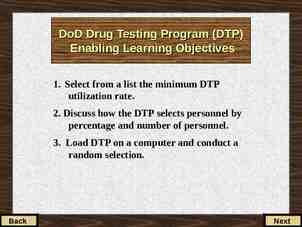8-1. Key Sanitation Condition No. 8: No pests in the food
11 Slides186.00 KB
8-1. Key Sanitation Condition No. 8: No pests in the food processing plant. 8-2. Foodborne illnesses that may be passed on by pests are numerous: Flies and cockroaches may transmit Salmonella, Staphylococcus, C. perfringens, C. botulinum, Shigella, Streptococcus, and others; Rodents are sources for Salmonella and parasites; and Birds are hosts for a variety of pathogens such as Salmonella and Listeria.
8-3. Goal: Monitoring must confirm that pests are excluded from relevant areas of the plant to the extent possible and should also confirm that procedures are followed to prevent infestation.
8-4. Monitoring for exclusion of pests: Visually inspect for presence of pests in processing areas; Use flashlight to expose potential hiding places and to check traps; and Maintain good housekeeping to facilitate inspections. 8-5. Corrections Example Observation: After pesticide and trap use, flies re-enter processing areas Correction: Add air curtain above outside door and move waste storage container away from door
8-7. Three phase pest control program: 1. Elimination of shelter and attractants; 2. Exclusion of pests from the food plant; and 3. Extermination of those pests that gain entry. 8-8. Complete Pest Exclusion Program: Required Monitoring 1. Presence / Absence of Pests. Related Conditions 1. Plant and Grounds; 2. Structure and Layout; 3. Plant Machinery, Equipment and Utensils; 4. Housekeeping; 5. Waste Disposal; and 6. Use of Pesticides and other Control Measure.
8-9. Example Pest Control Checklist (not required): Plant and Grounds 1. Are the grounds clear of weeds, tall grass, brush, and debris to minimize cover for pests to approach and enter the facility? 2. Is there standing water on the grounds which may attract pests? 3. Are traps sufficient in number, well maintained and in good repair? 4. Are there signs of the presence of domestic animals or large feral animals (including but not limited to dogs, cats or raccoons)?
8-10. Example Pest Control Checklist Continued for: Building / Facility 5. Do windows and doors seal tightly to prevent entry of pests or contaminants? 6. Do windows have screens in good repair to keep out insects? 7. Are there openings of 1/4-inch or greater that will allow entry of rodents and insects? 8. Are drains properly cleaned and free of buildup that may act as an attractant to rodents and other pests? 9. Is there sufficient clearance space (six-inch minimum between walls and equipment) to inhibit rodent activity? 10. Are drain covers in good repair and properly fitted?
8-11. Example Pest Control Checklist Continued for: Plant Machinery, Equipment and Utensils 11. Are machinery, equipment and utensils properly cleaned and sanitized to eliminate the build-up of food or other static materials that may act as an attractant to pests? 12. Is there sufficient space along the process line to allow for proper cleaning and sanitizing? 13. Are there any “dead spaces” which may allow for the build-up or collection of food and other debris acting as attractant or harborage of insects and bacteria? 14. Are blacklight units maintaining the proper light intensity levels to attract flying insects? 15. Are blacklight electrocution devices properly set up? 16. Are the blacklight electrocution device catch basins cleaned out regularly?
8-12. Example Pest Control Checklist Continued for: Housekeeping 17. Is trash, debris and clutter picked up eliminating cover for pests? 18. Are personnel locker rooms and break rooms cleaned and sanitized to inhibit the attractions of rodents and other pests? 19. Are there signs of rodent, insect, or bird habitation, e.g., droppings, hair, feathers, gnaw marks, grease runs from rodent activity along walls, urine/ammonia odors? 20. Have previously noted indicators of pest habitation been cleaned up in order to note any new or continued activity?
8-13. Example Pest Control Checklist Continued for: Waste Disposal 21. Is waste material properly collected, stored and disposed of in order to inhibit the attraction of rodents and other pests? 22. Are waste bins, tubs and/or dumpsters properly cleaned and sanitized in order to inhibit the attraction of rodents other pests?
8-14. Categories of Pesticide Use: 1. General use insecticides; and 2. Restricted use insecticides. 8-15. Certification of Applicators: 1. Private applicator; and 2. Commercial applicator.
8-16. General Standards for Applicator Certification: 1. Label and labeling comprehension; 2. Safety; 3. Environmental factors and the consequence of use and misuse of the pesticide; 4. Knowledge of pests; and 5. Knowledge of pesticides and types of formulations, including the hazards associated with residues.
















